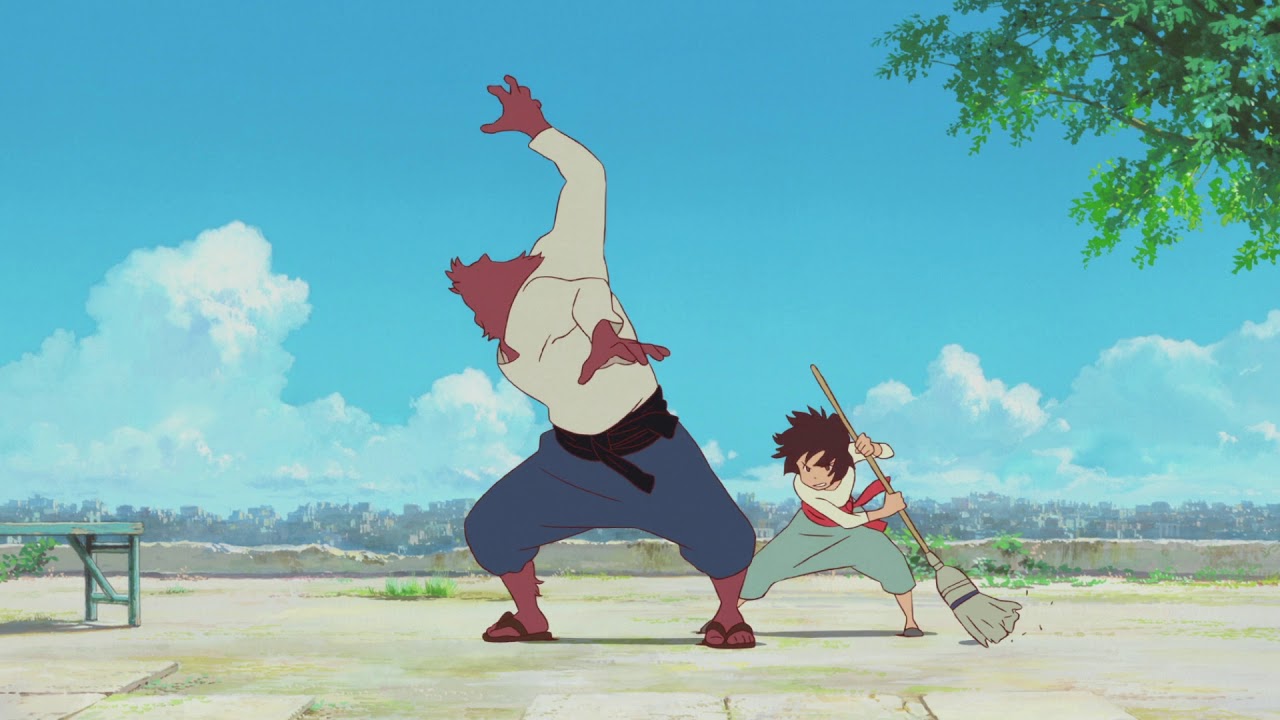By Chlotrudis Independent Film Society
Rating: 5 cats
Director: Mamoru Hosoda
Starring: Aoi Miyazaki | Kazuhiro Yamaji | Koji Yakusho | Suzu Hirose

Original language title: Bakemono No Ko
Country: japan
Year: 2016
Running time: 119
IMDB: http://www.imdb.com/title/tt2322517/
Jason says: “I’ve been wrong about these things on a fairly regular basis, so I’m not going to question the American release of Mamoru Hosada’s THE BOY AND THE BEAST on the same day that the Walt Disney Company puts out their own animated movie set in a city of animal people; maybe it will pick up some overflow from sold-out shows and introduce some new families to Japanese animation and one of its most exciting current filmmakers. If so, they’re in for a treat; it’s a terrific movie, mature but suitable for all but the youngest kids, smart and entertaining.
“We’re given a little background on Jutengai, a bustling city in a world of intelligent beasts connected to ours. Its Lord aims to reincarnate as a god in the next few years, and his successor will be chosen by a battle between warthog Iozen (voice of Kazuhiro Yamaji) and ursine Kumatetsu (voice of Koji Yakusho) – the former much-respected while the latter is strong but unrefined and disagreeable. Meanwhile, nine-year-old Ren (voice of Aoi Miyazaki) flees from his relatives after his mother dies, following a visiting Kumatetsu down a mysterious alley in Shibuya and to Juntengai. He becomes Kumatetsu’s pupil under the name ‘Kyuta’, although theirs is hardly a traditional teacher/student relationship. The other beasts are worried, though, as the blackness in human hearts is a well-known danger.
“There’s a visual reference to Moby Dick early on, and the book becomes an important touchstone later in the film, with Kaede (voice of Suzu Hirose), a bookish girl Ren meets when he is able to return to the human world, outright spelling out that it is less a battle between a man and a whale than one with himself. It’s clear from the start that this is a battle that both Kumatetsu and his apprentice are fighting and one where the other can serve as an important ally. The film never suffers for wearing its heart on its sleeve like this, though; by the time Kaede says this, we’ve already seen how bestial Ren appeared at first and has sent Kumatetsu and Kyuta on a pilgrimage to learn what strength is.
“For all that Hosada isn’t ashamed to put what he’s doing front and center, he’s also surprisingly inventive, especially since one might expect him to stumble writing his first screenplay without usual co-writer Satoko Okudera. He deploys the image of Ren’s dead mother with great care, for instance, letting the audience feel what the loss means to him despite never actually seeing her as anything else. He goes interesting places when Ren rediscovers the human world, proving surprisingly gentle in demonstrating the pull it exerts on Ren. He telegraphs what the ultimate conflict of the story will be, but the details intrigue, and the action-filled last act, when many films would be pushing characters to emotional extremes, has a great deal of introspection and emotional connection, though not with the sort of detached philosophizing that derails many an anime.
“It’s a sight to see, as well. The opening sequence has Hosada having a little fun with some of the most obviously digital bits of the film, though he mostly keeps with the traditional hand-drawn look. There’s a disarming simplicity to many of the designs and shots where detail is not needed, but the characters who need to be the most expressive are, and brilliantly so: Kumatetsu seldom gets twisted or distorted, but still communicates his personality most vividly through body language, while Kyuta starts out all gangly arms and messy hair but seems to stabilize as he grows, even filling out in such a way that the audience likely won’t catch how smoothly an animated character can grow. One of Hosada’s underrated talents is that, despite his characters often having quite simple designs, they remain easily recognizable as they age, grow, don different clothes and change hairstyles.
“It’s not just subtle stuff, though – though the Lord is a wise old rabbit, there’s a bit of Bugs Bunny in him as he jumps from one place to another as soon as you take your eyes off him. The big action sequence in the end is impressively grand in scale without changing style too much from the rest of the movie (though Hosada does use different looks at times, especially when using surveillance cameras in the human world). There are some impressive bits of design work, such as the form that the darkness the beasts fear takes, but what’s most delightful is how light on their feet characters feel during the martial-arts sequences; the natural movement seems so perfect that I’d suspect rotoscoping, except that seldom looks so smooth.
“The film was presented in subtitled Japanese at my local theater, although I gather that it is playing with an English-language soundtrack at some venues; I strongly suspect that the original Japanese is preferable. Even leaving the soundtrack out of it, THE BOY AND THE BEAST is a fantastically-crafted movie, not ostentatious and with some edges left appropriately rough, but quietly near-perfect in nearly every way. 5 cats
“Seen 4 March 2016 in AMC Boston Common #17 (first-run, DCP)”
